|
At the request of website visitor
Guillermo A ., here is the article for Dick Eipper's Flexi-Flier
Rollago wing for R/C.
I electronically scanned the article, including images, from my purchased copy of the
April 1974 American Aircraft Modeler magazine, beginning on page 21. It is a 1/6-scale
version of the original that uses a GI Joe as the functional pilot. You might be able
to scale up the image below if you cannot find suitable plans for sale. The article was
written and plans drawn by Mr. Frank G. Kelly. All copyrights (if any) are hereby acknowledged.
See also The Insect free flight
model.
Flexi-Flier
Frank G. Kelly
Hang gliding is a new fad that is getting a great response on both coasts.
This distinctive scale model of a Rogallo wing glider is not only fun, but somehow
mysterious...
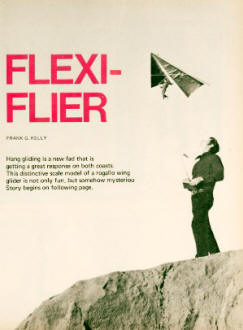 I first became aware of hang gliders in their
present form when I met Bill Moyes. While experimenting with a Rogallo wing as a potential
sidelight to his Australian water ski exhibitions, Bill discovered that he had broken
the altitude records for such things. Perhaps more significant, he found that the rogallo
wing ski-kite was a stable aircraft with the line slack or disconnected. The conventional
water ski-kite is in no way stable with a slack line. When Bill showed the movie of himself
jumping off the south rim of the Grand Canyon for a nine-min. flight to the river, I
knew I was hooked! On another occasion, he was towed to 10,000 ft. by an airplane, then
he released himself to glide back. I first became aware of hang gliders in their
present form when I met Bill Moyes. While experimenting with a Rogallo wing as a potential
sidelight to his Australian water ski exhibitions, Bill discovered that he had broken
the altitude records for such things. Perhaps more significant, he found that the rogallo
wing ski-kite was a stable aircraft with the line slack or disconnected. The conventional
water ski-kite is in no way stable with a slack line. When Bill showed the movie of himself
jumping off the south rim of the Grand Canyon for a nine-min. flight to the river, I
knew I was hooked! On another occasion, he was towed to 10,000 ft. by an airplane, then
he released himself to glide back.
During
the past year or so, hundreds of young people in the Los Angeles area have assembled
hang gliders, mostly the products of available hardware. Some are frightening creations
of bamboo, clothesline and garbage bags; others are very professional, made of the proper
kind of aluminum tubing, stainless steel cable, and rip-stop Dacron.
The one modeled here is a nearly exact 1/6 scale "Flexi-Flier," a popular contemporary
design by Dick Eipper. (If you want to build a full-size glider, get a set of plans from
him. DO NOT scale the model plans up. Parts and materials must be carefully selected
to avoid disaster!) Dave Cosgrove recently flew one (full-size) continuously for over
two hours in unusually favorable conditions near Palmdale!
The model, like the prototype, has a primitive but interesting and effective control
system. Pitching and turning is done by shifting the center of gravity by means of body
english. The pilot is suspended from a harness or swing seat, and the control bar provides
something to push against. The model is equipped with only two muscles, so the body is
suspended from a string leading under the arms and around the back. This worked out much
better than any of the more scale versions, and does not detract from the appearance.
It is interesting to note, if only for academic interest, that this control system is
effective at zero velocity. Ponder that during your next hammerhead stall.
|
 The mannequin
doll looks like a robot from science fiction as he admires his electronic innards in
a mirror. Even with KPS-10 size servos, there is adequate room inside the chest for a
complete flight package.
 The doll in
position on his hang bar, amid a maze of rigging. Tow hook release bridle is shown here.
GI Joe is also available with a beard.
 GI Joe takes
a hop aboard his Flexi-Flier. Note that the author holds the transmitter at a 45° angle,
a clever way to get elevon control. Watch that you don't detune the signal by accidentally
grounding the antenna with your hand. (Photo by Jerry Trager) |
Now ponder this: Two rotary servos operate the two arms. BOTH must move for each direction.
To pitch up, move BOTH arms forward to cause the body to move back. To pitch down, move
BOTH arms the other way. To turn right, move RIGHT arm back and LEFT arm forward (try
this while holding onto an imaginary towel bar).
To effect this complex set of motions, simply rotate the transmitter 450. This way
the aileron/elevator stick operates in a normal manner: "forward" moves both servos in
such a way that the model responds appropriately. Right stick turns right, etc., and
after just a few min., the controls feel quite natural. The same system could be used
for a V-tail airplane with NO extra linkage! The completed glider weighs just eight oz.;
after his extensive transplant, GI Joe weighs one lb.
The model didn't take long to assemble, but working with 0-80 screws involves some
fumbling, at best. I bought a 12-ft. length of 1/4" 2024-T3 aluminum tubing from a nearby
industrial supply house and settled for .028 wall thickness, rather than the more scale
.008. This was a good thing because it has to take some lumps. All the rest of the materials
are available at hobby shops or hardware stores, although finding long steel 0-80 screws
is something of a challenge. I made a drill jig out of a block of wood to help get the
little holes lined up properly.
The rest of the assembly is pretty much straightforward, with just a few exceptions.
The thimbles for the cable loops were made by threading bare copper wire through a piece
of 1/16 aluminum tubing. This was wrapped tightly around a long 4-40 screw and chucked
up in a drill motor. After filing half way through, the copper wire was removed and the
aluminum tubing sawed lengthwise with a modeling saw. This provided a handful of split
rings which resembled thimbles. The crimped ferrules were made of short bits of brass
tubing and crimped carefully with wire cutters. They're too small to crimp any other
way.
The control bar was made of 1/8" soft aluminum hobby tubing but, since strength was
necessary here, I selected a coat hanger which fit inside snugly. Music wire won't do
because it has to be drilled. Bending is easy with the wire inside.
Now that the hang glider is finished, you'll need a pilot. You've survived the jibes
about playing with little toy airplanes, so don't worry about playing with dolls again.
GI Joe is really a remarkable doll, beautifully articulated to move in all the proper
pl-aces. Pull an arm and a leg out of their sockets and snip the elastic holding them
on. Now saw through the torso at shoulder height. I did this on my table saw and found
it to be a curiously satisfying experience! My radio is a six-channel Kraft with KPS-10
servos and I found it necessary to discard GI Joe's hip sockets to make room for the
radio. With a two- or four-channel rig and KPS-12 servos, you might be able to retain
them, but it's not terribly important.
The two servos are taped together back-to-hack with the rotary shafts available for
attaching to the arms at the shoulders. The receiver can now be slipped between the bottom
mounting ears of the servos. This will locate the "brains" appropriately in the seat
of his pants. The flat battery pack will fit in the chest area. There's even room for
a switch under the battery in the general vicinity of the belly button. An S- shaped
wire hook can attach the head to the neck, and a 4-40 screw holds the legs together in
the upper thigh. A big rubber band holds the head and legs on like suspenders.
Drill out the wrist and elbow rivets and tap to accept 4-40 headless set screws. Carve
these joints until they move freely. Remove the rivet from the shoulder area of the upper
arm, and with a small soldering iron, fill in the area where the hook had been. The plastic
melts and fuses easily. When cool, cut a square hole to accept the servo output shaft
and screw on the arms. The flight suit can now be slipped over the pilot and when zipped,
he can't be distinguished from the original G I Joe. At this point, he is capable of
doing pushups to get in training. With the doll suspended from his armpits, and his hands
attached to the control bar with little rubber bands, the effect is absolutely captivating!
He swings around in a very realistic way.
Flight characteristics of the completed model were very realistic. it has about a
five-to-one glide path (remember, this is a glider, not a sailplane), and will flare
out very nicely for landing. Upon landing, the legs swing back gently and everything
is protected by the hang bar and rigging. Control capability is about the same as the
prototype, but I found that control could be overpowered by a strong updraft. A half-oz.
fishing sinker in the nose corrected this .
|
The mini-man does his thing. Control inputs should find the doll in each of the positions
shown:
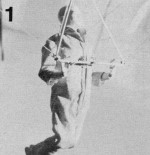 Neutral
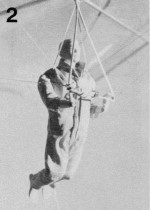 Left turn
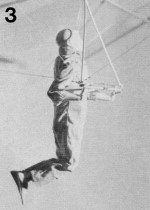 Right turn
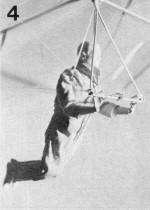 Up elevator
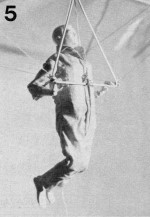 Down elevator.
It's a real marvel just to watch the mechanical man do tricks.
|
For the first few test flights, follow the technique used by the big ones. Find a
gentle slope which the prevailing wind blows toward and which has a loose sand surface.
start at the BOTTOM and, holding the model loosely at the top of the control bar, get
the feel of wind filling the sail and lifting the craft. Avoid touching the transmitter
antenna while holding it sideways because it will detune somewhat. Now make sure that
the sail is filled. Ease it gently straight into the wind and slightly downward. The
shove will cause the body to swing aft, giving it a tendency to pitch up a little.
After a few preliminary flights like this, you can start working your way up the h
ill. Notice that you haven't gotten into a dangerous situation yet. I f nothing works,
the worst thing that can happen is a mild jolt. The jump suit helps to keep sand out
of everything but doesn't prevent it. Finally, standing on the edge of the cliff, point
the hang glider directly into the wind and launch. It will gain altitude as, it moves
through the updraft, and the model can compete with a full-size manned hang glider on
absolutely equal terms. Sink rate, glide path, and directional control are all quite
comparable. The only problem is that everyone stops flying and crowds around to watch
when the model is there! If you become inured to the thrills of jumping off cliffs
in relative safety, you can add the tow hook release mechanism. Full "up" control pulls
the body back, and a string from the chest releases the catch. Full-size ones use a motorcycle
clutch cable. Towing is much more dangerous than cliff jumping, because the rigging can
be overstressed at high angles of attack. Higher speeds are attained, and it is possible
to get into a condition which cannot be corrected before impacting. Longer flights can
be sustained with the model though, and it makes for another interesting novelty. With
the tow hook, the model can be flown like a kite, towed aloft like a tow line glider,
launched with a long rubber band, towed from another RC craft (I'd like to try water
skis behind an RC boat, but GI Joe hasn't learned to swim yet), or dropped from a weather
balloon. My longest flight so far was from a manned hot air balloon at 5000 ft.
Braided fishing line is hollow like polypropylene water ski tow rope, and a loop can
be formed by threading an end back into the core. This bridle can be attached to the
control bar with a clove hitch. The towline has a drapery ring on the end, through which
the bridle is threaded. The ring can ride up and down the bridle freely and the pitching
moment induced by towing can be overcome. (If the towline is attached directly to the
control bar, the pitching moment will cause an immediate problem.) Upon release, the
bridle pulls through the ring and comes free. For the balloon launch, I melted a small
hole in the sail with a soldering iron and allowed the bridle loop to pull through at
release.
Under tow, the model has much more lateral control than in a free glide, due to the
way the different forces act and the moments associated with them. For this reason, the
kite technique is suggested for training purposes before attempting a tow. The ground
speed is initially zero. It is still possible for undampened oscillations to build up,
with hard dirt at both ends; so be prepared to release the instant a dangerous situation
develops. I f you can find another RC modeler willing to tow you up with his airplane,
the following precautions are important: attach the airplane tow hook , just behind the
cockpit, not at the tail.
Also, arrange for either end of the line to be released in an emergency. The tow plane
can use a spare channel or release with full left rudder. The glider can get airborne
in the first few t., then after a brief period of uncertainty, both can fly together.
Use a 50-ft. towline of four-lb. test nylon monofilament fishing line. It will stretch
a little, maintaining tension under load, and will break if overstressed. Teamwork is
required to pull this off. Gentle turns and a steady pull are important. The tow pilot
should throttle back a bit at release to avoid overstressing the glider rigging, but
also I the release will pitch the glider up, slowing down the tow plane. If the tow plane
turns down and left at release while the glider turns right and down, there will be less
of a tendency to interfere with one another.
If you like something different, try a hang glider. It is in no way an improvement
over more conventional aircraft, but it's fun and very easy to fly.
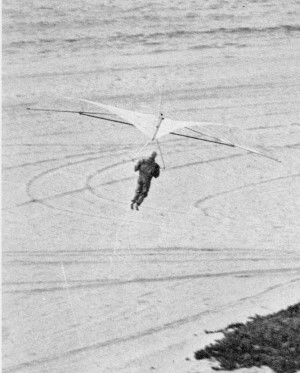
 <click for larger version>
Notice:
The AMA Plans Service offers a
full-size version of many of the plans show here at a very reasonable cost. They
will scale the plans any size for you. It is always best to buy printed plans because
my scanner versions often have distortions that can cause parts to fit poorly. Purchasing
plans also help to support the operation of the
Academy of Model Aeronautics - the #1
advocate for model aviation throughout the world. If the AMA no longer has this
plan on file, I will be glad to send you my higher resolution version.
Try my Scale Calculator for
Model Airplane Plans.
Posted June 10, 2010
|